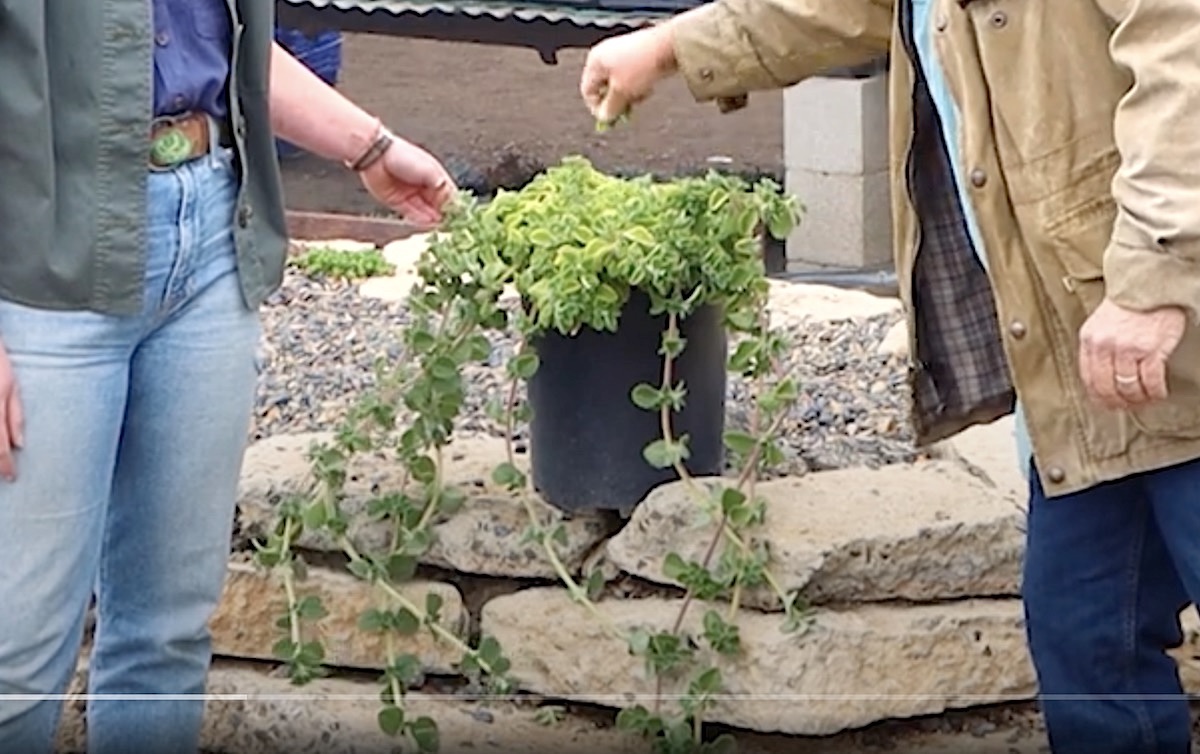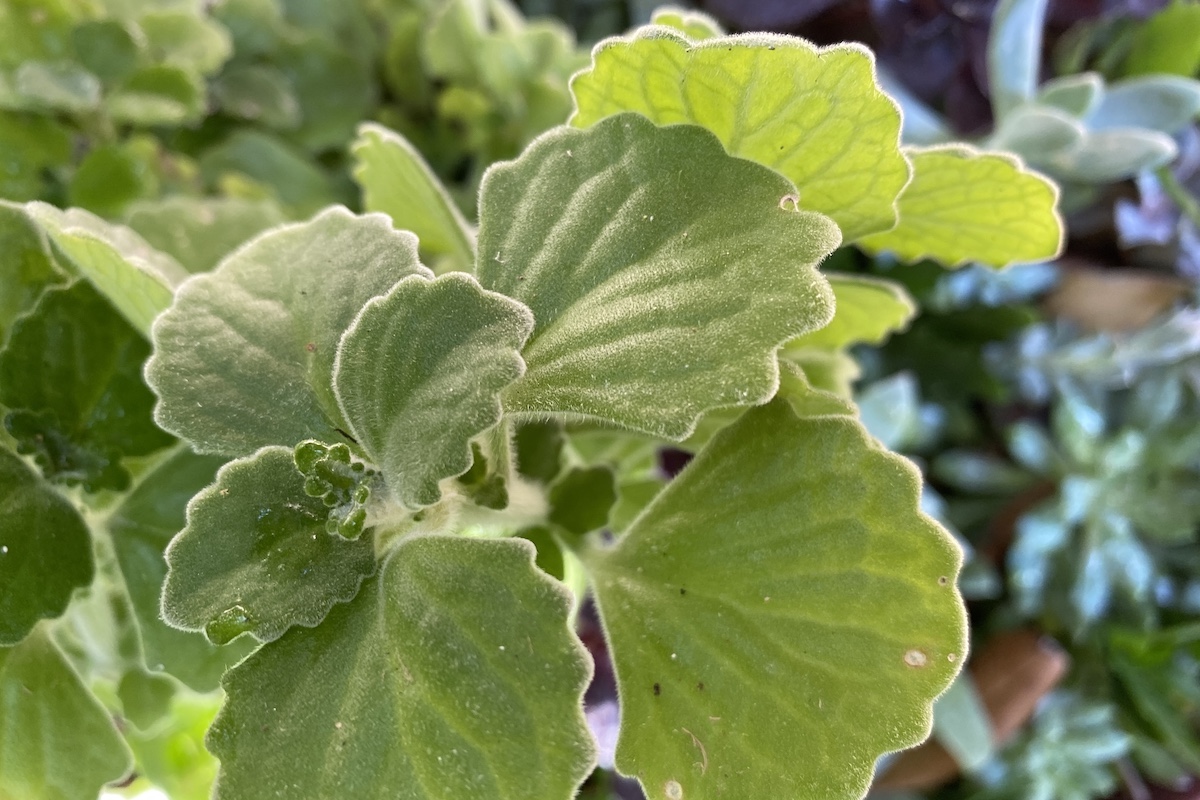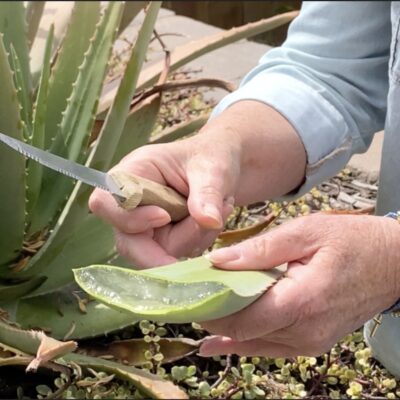
Comfort Plant Benefits
If you've been to my garden recently, Mama Debra has slathered "Comfort Plant" juice on your bug bites, scrapes or---if you brought your dog---hot spots.
I’m informally testing the herbal benefits of Plectranthus amboinicus, a semi-succulent with velvety, juicy leaves.
If you think "stinky" when it comes to Plectranthus, think again. Unlike better-known species, comfort plant doesn't smell like cat urine or Vicks. I actually like its eucalyptus-camphor aroma.

Comfort Plant in my garden. Leaves are one to two inches wide.
In the mint family, it's an edible, pleasant-looking addition to the garden. But what's exciting is that this Asian-African perennial's therapeutic benefits may exceed those of Aloe vera.
What Scientists Say
As you know, I'm both journalist and horticulturist. I'm highly skeptical of high-falutin' claims---and you should be too. But after researching comfort plant, I've found that scientists credit it with properties beyond my expectations. Here are two examples (there are others):
According to the scientific journal Molecules (March, 2016), "Botanical, Phytochemical, Pharmacological and Nutritional Significance of Plectranthus amboinicus":
“Studies have cited numerous pharmacological properties including antimicrobial, antiinflammatory, antitumor, wound healing, anti-epileptic, larvicidal, antioxidant and analgesic activities. Also, it has been found to be effective against respiratory, cardiovascular, oral, skin, digestive and urinary diseases. This article allows researchers to further explore the further potential of this multi-utility herb for various biomedical applications."
From the journal of Evidence-Based Complementary and Alternative Medicine, “Analgesic and Antiinflammatory Activies of the Aqueous Extract from Plectranthus amboinicus,” 2012:
"This herb has therapeutic and nutritional properties attributed to its natural phytochemical compounds which are highly valued in the pharmaceutical industry. Besides, it has horticultural properties due to its aromatic nature and essential oil producing capability. It is widely used in folk medicine to treat conditions like cold, asthma, constipation, headache, cough, fever and skin diseases. The leaves of the plant are often eaten raw or used as flavoring agents, or incorporated as ingredients in the preparation of traditional food."
Where To Find It
I first learned about Comfort Plant when Annie Schreck of Mountain Crest Gardens and I visited Waterwise Botanicals nursery. WWB's Tom Jesch shared his personal experiences with the herb. (Those of you who know Tom know he has health issues---I hope I'm not being indiscreet in mentioning that.)
These two nurseries, both of which I respect highly, are introducing comfort plant to USA markets this month. If you live within driving distance, obtain it at Waterwise Botanicals north of San Diego; if not, online from Mountain Crest Gardens.

NEW VIDEO: "How do you get the juice?" botanical researcher Annie Schreck of Mountain Crest Gardens asks Tom Jesch of Waterwise Botanicals nursery.
Comfort Plant Care
Comfort Plant is as easy to grow as mint or, say, scented geraniums. Similar to trailing succulents, it wants:
- good soil
- protection from harsh midday sun, especially in summer
- good air circulation
- regular water
- protection from frost
- fertilizer to encourage lush growth
As you would any plant you might use in tea or salads, don't apply pesticides. And don't overdo it. High doses could be toxic, so err on the side of caution.
My own Comfort Plant (thank you, WWB) is in my side-yard nursery where new plants land. I'll soon move it to a hanging pot where stems can trail several feet, leaves are easy to harvest, and it'll be sheltered from cold in winter.
Say, if you were here recently, how's that rash?
LEARN MORE about this new-yet-ancient herb on the...
Related Info
Why You Should Grow Aloe Vera
Can you grow Aloe vera in your garden as an ornamental plant and harvest its medicinal leaves? Yes, but heed cautions below. This midsized succulent with tall, slender yellow flowers is famous for gel that soothes minor burns and skin irritations.


I’ve used Plectranthis Amboinicus (your Comfort Plant article) when I have Euphorbia sap in my eye. Juice the leaves into my palm and apply in my eye. Takes the burn from a several hour problem to about a 30 min issue. I’m not a horticulturist but I learned this from one… 🙂
On a happier note, Euphorbia Firestick gets its best color in cool weather, when it turns more electric orange and gorgeous.